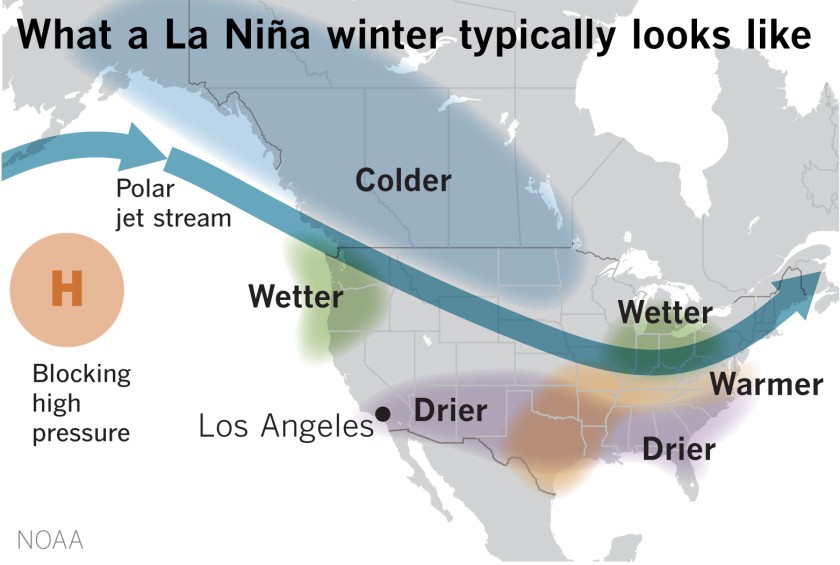It’s looking increasingly likely the U.S. will see La Niña conditions this winter, something that could spell bad news for an already parched Southern California.
As of Thursday, NOAA’s Climate Prediction Center says there’s a 70% chance that La Niña returns for a second straight winter, this time between the period of November 2021 and January 2022. As such, a La Niña Watch has been issued by the agency.
So what does that mean for winter weather?
“It really depends where you are in the United States. It will vary by location,” explained NOAA climate scientist Michelle L’Heureux. “The southern tier during a La Niña is often drier than average during the winter, and that often extends into spring.”

That southern tier includes Southern California, as well the southwestern states, plus Texas and the Gulf Coast states through to Florida. For those areas, there’s a 40% chance of below-average precipitation, L’Heureux said.
“You might think 40% doesn’t seem that large, but remember we have three possible outcomes: below average, near average and above average,” she explained. “It’s not a coin flip. There are three potential outcomes. That means randomly you can get 33%, so a 40% chance really does mean we favor below-average conditions.”
That means the most likely outcome for drought-plagued the Southwest could be even more dry conditions. In California, 88.4% of the state is currently experiencing extreme drought, and nearly half the land is mired in the exceptional drought — the most intense of the five categories.
That followed an extremely dry winter that saw little rainfall, particularly in the Southland, which has seen its drought conditions steadily deteriorate. In fact, most of Southern California was drought-free this time last year.
The Golden State’s summer has thus far already been marked by extreme heat and destructive wildfires such as the Dixie Fire, which has charred nearly 900 square miles across four Northern California counties and is the state’s largest brush fire in history.
Still, the outcome of another potentially dry winter is not a certain one.
“La Niña doesn’t mean anything absolutely,” L’Heureux said. “Just saying there’s going to be a La Niña doesn’t mean it’s going to be dry and drought. We have certainly had La Niña winters where, lo and behold, there’s more precipitation than expected. That’s just less common.”
While La Niña could mean bad news for the Southwest, the opposite may be true for the Pacific Northwest, where the winter weather pattern tends to bring more precipitation, not less, according to the climate scientist.
But How La Niña affects the Northeast is the biggest mystery, L’Heureux says. It’s pretty much equal chances of a wet or dry winter. Only time will tell exactly how La Niña plays out — something that makes L’Heureux’s job challenging.
“Climate is not as predictable as the weather,” she said.
Correction: An earlier version of this story spelled L’Heureux’s last name wrong. The post has been updated.













